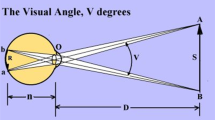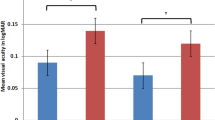Abstract
Background/aims
Amblyopia is the most common visual deficit in children and accurate visual acuity (VA) assessment is essential for diagnosis. While ETDRS high-contrast logMAR VA is the reference standard test for adults, less agreement exists for pre-literate children. A new picture optotype acuity test (The Auckland Optotypes [TAO]) has shown favourable comparison to letter acuity charts but has not yet been evaluated in children with amblyopia. This study aimed to compare VA obtained using TAO to crowded logMAR letters in children age 5–8 years with amblyopia.
Methods
Children with amblyopia (n = 54 [20.37% strabismic, 18.52% anisometropic, 61.11% mixed], mean age 78.30 ± 11.72 months) were recruited from paediatric ophthalmology/orthoptic clinics at Moorfields Eye Hospital NHS Foundation Trust, London, and Cambridge Community Services NHS Trust, Bedford. Best-corrected VA was measured in both the amblyopic eye (AE) and fellow eye (FE) using TAO and a crowded letter acuity chart. Bland–Altman analysis was used to measure 95% limits of agreement (LoA) for VA measures captured (AE, FE and interocular difference [IOD]).
Results
Good agreement between TAO and letter VA measurement was observed (mean bias: AE –0.01, FE 0.01, IOD –0.02). For AE measures 95% LoA were from –0.25 to 0.24 logMAR, this being similar for FE (–0.24 to 0.25) and IOD measures (–0.30 to 0.27).
Conclusion
TAO and letters elicited similar VA in children with amblyopia. TAO could be a useful picture-based chart for paediatric vision assessment.
Similar content being viewed by others
Log in or create a free account to read this content
Gain free access to this article, as well as selected content from this journal and more on nature.com
or
References
Kay H. New method of assessing visual acuity with pictures. Br J Ophthalmol. 1983;67:131–3.
Anstice NS, Jacobs RJ, Simkin SK, Thomson M, Thompson B, Collins AV. Do picture-based charts overestimate visual acuity? Comparison of Kay Pictures, Lea Symbols, HOTV and Keeler logMAR charts with Sloan letters in adults and children. PLoS One. 2017;12:e0170839.
O’Boyle C, Chen SI, Little JA. Crowded letter and crowded picture logMAR acuity in children with amblyopia: a quantitative comparison. Br J Ophthalmol. 2017;101:457–61.
Shah N, Laidlaw DA, Rashid S, Hysi P. Validation of printed and computerised crowded Kay picture logMAR tests against gold standard ETDRS acuity test chart measurements in adult and amblyopic paediatric subjects. Eye (Lond). 2012;26:593–600.
Milling A, Newsham D, Tidbury L, O’Connor AR, Kay H. The redevelopment of the Kay picture test of visual acuity. Br Ir Orthopt J. 2015;13:14–21.
Hamm LM, Yeoman JP, Anstice N, Dakin SC. The Auckland Optotypes: an open-access pictogram set for measuring recognition acuity. J Vis. 2018;18:13.
Hamm LM, Langridge F, Black JM, Anstice NS, Vuki M, Fakakovikaetau T, et al. Evaluation of vision screening of 5-15-year-old children in three Tongan schools: comparison of The Auckland Optotypes and Lea symbols. Clin Exp Optom. 2020;103:353–60.
Hamm LM, Anstice NS, Black JM, Dakin SC. Recognition acuity in children measured using The Auckland Optotypes. Ophthalmic Physiol Opt. 2018;38:596–608.
Group PEDI. The clinical profile of moderate amblyopia in children younger than 7 years. Arch Ophthalmol. 2002;120:281–7.
Holmes JM, Kraker RT, Beck RW, Birch EE, Cotter SA, Everett DF, et al. A randomized trial of prescribed patching regimens for treatment of severe amblyopia in children. Ophthalmology. 2003;110:2075–87.
Dobson V, Clifford-Donaldson CE, Miller JM, Garvey KA, Harvey EM. A comparison of Lea Symbol vs ETDRS letter distance visual acuity in a population of young children with a high prevalence of astigmatism. J Aapos. 2009;13:253–7.
Shah N, Dakin SC, Redmond T, Anderson RS. Vanishing Optotype acuity: repeatability and effect of the number of alternatives. Ophthalmic Physiol Opt. 2011;31:17–22.
Carkeet A. Modeling logMAR visual acuity scores: effects of termination rules and alternative forced-choice options. Optom Vis Sci. 2001;78:529–38.
Ferris FL, Freidlin V, Kassoff A, Green SB, Milton RC. Relative letter and position difficulty on visual acuity charts from the Early Treatment Diabetic Retinopathy Study. Am J Ophthalmol. 1993;116:735–40.
Sloan LL, Rowland WM, Altman A. Comparison of three types of test target for the measurement of visual acuity. Q Rev Ophthalmol. 1952;8:4–16.
Acknowledgements
The authors would like to thank Professor Steven Dakin for his assistance in illustration of TAO optotypes for this paper. We also express our gratitude to the patients of Moorfields Eye Hospital Paediatric Clinic and Cambridge Community Services (Bedford) Eye Clinic and their parents/guardians who kindly gave their time to participate in this research.
Funding
Supported in part by an in-practice research grant from the College of Optometrists (EMMcV), a research award grant from the British Isles Paediatric Ophthalmology and Strabismus Association (BIPOSA) (SML) and by the National Institute for Health Research (NIHR) Biomedical Research Centre based at Moorfields Eye Hospital NHS Foundation Trust and UCL Institute of Ophthalmology (AD-N, PJM, NS). The views expressed are those of the authors and not necessarily those of the NHS, the NIHR or the Department of Health.
Author information
Authors and Affiliations
Contributions
EMMcV was responsible for the College of Optometrists funding application, assisting with ethics application, recruitment of participants, acquisition of data, statistical analysis and drafting the final manuscript. SML was responsible for the initial study design and concept, protocol development, BIPOSA funding application, ethics application, recruitment of participants, acquisition of data, statistical analysis and drafting the final manuscript. SM was responsible for the recruitment of participants at site 2 and acquisition of data. NS was responsible for assisting in the College of Optometrists funding application, editing the final manuscript, administrative, technical or material support and supervision. PJM was responsible for assisting in the College of Optometrists funding application and editing the final manuscript, statistical analysis, administrative, technical or material support and supervision. AD-N was responsible for the initial design and concept of the study, NIHR Biomedical Research Centre grant application, ethics application, overseeing the study, editing the final manuscript, statistical analysis, administrative, technical or material support and supervision. EMMcV and SML had full access to all the data in the study and take responsibility for the integrity of the data and the accuracy of the data analysis. All authors contributed to analysis/interpretation of data, drafting of the manuscript and critical revision of the manuscript for important intellectual content.
Corresponding author
Ethics declarations
Competing interests
PJM: Heidelberg Engineering & LKC Inc. (research support). NS: The Moorfields Acuity Chart (co-inventor) and COMPlog Clinical Vision Measurement Systems Ltd. (research support). AD-N: Santen Inc. (medical advisor).
Additional information
Publisher’s note Springer Nature remains neutral with regard to jurisdictional claims in published maps and institutional affiliations.
Rights and permissions
About this article
Cite this article
McVeigh, E.M., Ludden, S.M., Mohamed, S. et al. Preliminary clinical validation of a new picture–based visual acuity test in children with amblyopia: a comparison of The Auckland Optotypes and crowded logMAR letters. Eye 36, 2341–2345 (2022). https://doi.org/10.1038/s41433-021-01840-3
Received:
Revised:
Accepted:
Published:
Issue date:
DOI: https://doi.org/10.1038/s41433-021-01840-3



